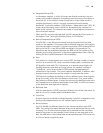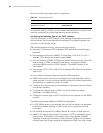82 CHAPTER 5: IP ROUTING PROTOCOL OPERATION
the protocol packets to each other. Thus, each router receives the LSAs of other
routers and all these LSAs constitute its LSD.
■ LSA describes the network topology around a router, so the LSD describes the
network topology of the entire network. Routers can easily transform the LSD
to a weighted directed graph, which actually reflects the topology of the whole
network. All the routers have the same graph.
■ A router uses the SPF algorithm to calculate the shortest path tree which shows
the routes to the nodes in the autonomous system. In this tree, the router is the
root. The external routing information is a leaf node. A router that advertises
the routes, also tags them and records the additional information of the
autonomous system. Therefore, the routing tables obtained from different
routers are different.
OSPF supports interface-based packet authentication to guarantee the security of
route calculation. OSPF also transmits and receives packets by IP multicast.
OSPF Packets
OSPF uses five types of packets:
■ Hello Packet
The Hello packet is the most common packet sent by the OSPF protocol. A
router periodically sends it to its neighbor. It contains the values of some
timers, DR, BDR and the known neighbor.
■ Database Description (DD) Packet
When two routers synchronize their databases, they use the DD packets to
describe their own Link State Databases (LSDs), including the digest of each
LSA. The digest refers to the HEAD of an LSA, which can be used to uniquely
identify the LSA. Synchronizing databases with DD packets reduces the traffic
size transmitted between the routers, since the HEAD of an LSA only occupies a
small portion of the overall LSA traffic. With the HEAD, the peer router can
judge whether it has already received the LSA.
■ Link State Request (LSR) Packet
After exchanging the DD packets, the two routers know which LSAs of the
peer routers are missing from the local LSD’s. In this case, they send LSR
packets to the peers, requesting the missing LSAs. The packets contain the
digests of the missing LSAs.
■ Link State Update (LSU) Packet
The LSU packet is used to transmit the needed LSAs to the peer router. It
contains a collection of multiple LSAs (complete contents).
■ Link State Acknowledgment (LSAck) Packet
The packet is used for acknowledging received LSU packets. It contains the
HEAD(s) of LSA(s) requiring acknowledgement.
Basic Concepts Related to OSPF
■ Router ID
To run OSPF, a router must have a router ID. If no ID is configured, the system
automatically selects an IP address from the IP addresses of the current
interface as the router ID.


















